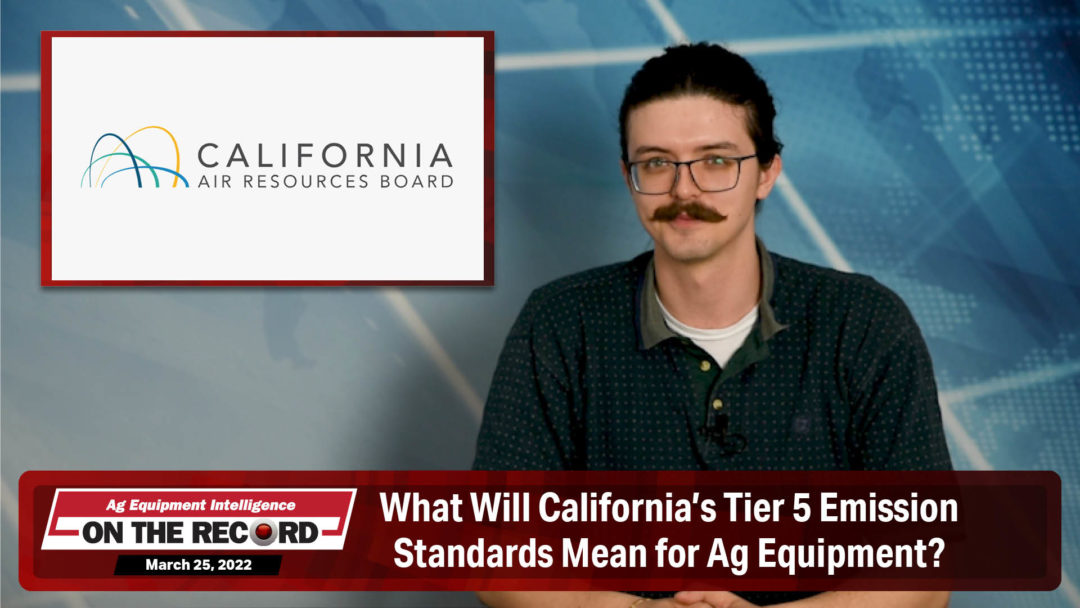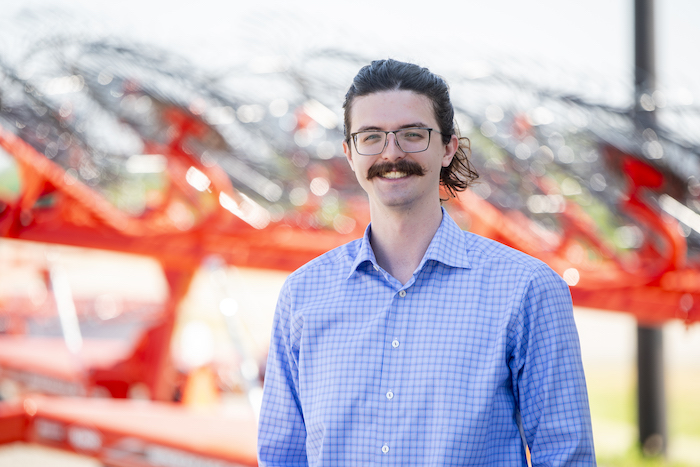The latest episode of On the Record is now available!
In this episode of On the Record, we look at the Tier 5 emission standards being proposed for California and what it could mean for the ag equipment market. In the Technology Corner, Michaela Paukner looks at how Krone and Lemken partnered to create an autonomous machine for forage harvesting and tillage, the Combined Powers machine. Also in this episode: CNH Industrial CEO Scott Wine addresses competition between the company's Case IH and New Holland dealers, and we take a look at Case IH dealer Titan Machinery's fiscal year 2022 earnings report.
This episode of On the Record is brought to you by Weasler Engineering.
Deliver a seamless transfer of power between a tractor and its attached machinery with one of Weasler’s three ASABE-compliant drive shaft product lines; the Standard, the Classic and the Professional. Weasler’s Newest product line – the Standard- offers a selection of pre-configured driveshafts. The Classic and Professional lines offer variety of standard components to choose from, allowing you to customize your PTO drive shaft to meet the specifications of your job. Learn more about what Weasler can do for you by visiting Weasler.com.
On the Record is now available as a podcast! We encourage you to subscribe in iTunes, the Google Play Store, Soundcloud, Stitcher Radio and TuneIn Radio. Or if you have another app you use for listening to podcasts, let us know and we’ll make an effort to get it listed there as well.
We’re interested in getting your feedback. Please feel free to send along any suggestions or story ideas. You can send comments to kschmidt@lessitermedia.com.
What Will California’s Tier V Emission Standards Mean for Ag Equipment?
Dealers, manufacturers and their customers may be facing Tier 5 emission standards in California by the end of the decade.
On Nov. 3 of last year, the California Air Resources Board held a public workshop to discuss “more stringent exhaust standards for all off-road engine power categories.” California’s Tier 4 standards were adopted in 2004, and the Board states on its website that with modern technology, greater reductions in emissions “are now feasible beyond the current Tier 4 standards.”
The Board’s proposal is tentatively scheduled for consideration in September 2024 and would be implemented in 2028. Some of the standards being considered include a 90% reduction vs. Tier 4 in oxides of nitrogen emissions for engines between 75-750 horsepower. This would include a 75% reduction in particulate matter emissions in the same range. Both emission types would be reduced about 75% for the 11-75 horsepower range and by 50% for the 11 and under and over 750 horsepower ranges.
Some of the standards being considered include a 90% reduction vs. Tier 4 in oxides of nitrogen emissions for engines between 75-750 horsepower. This would include a 75% reduction in particulate matter emissions in the same range. Both emission types would be reduced about 75% for the 11-75 horsepower range and by 50% for the 11 and under and over 750 horsepower ranges.
According to a November 2021 report from Diesel Net, California’s Tier 5 standards will require a similar standard being enacted by the Environmental Protection Agency to be effective. The federal Clean Air Act Amendments of 1990 preempt California’s authority on controlling emissions on new farm and construction equipment under 175 horsepower. Additionally, since there are no regulations prohibiting non-compliant equipment being brought in from other states, Tier 5 standards raising California equipment costs could see customers leaving the state for purchases.
Martha Hennigan, director of sales operations and marketing at electric tractor manufacturer Solectrac, says the implementation of 2014’s Tier 4 Final Standards created a rush to buy less expensive units before regulations took effect. She also says current California non-emission regulations on equipment up to the zero-turn mower range already have landscapers stockpiling equipment.
Hennigan says she expects the Tier 5 regulations will positively influence the sales of electric equipment. She doesn’t expect Tier 5 standards to bring another 25% price increase like Tier 4 standards did, but she says Tier 5’s presence will further alert buyers to the advantages of electric farm machinery, saying:
“Battery technology will be advancing at the same time that diesel prices will be going up. The changes in pricing will benefit the electric-powered units.”
Hennigan adds that she believes California’s non-emissions regulations will soon be raised to the subcompact and compact tractor categories as well, predicting it will happen before 2027.
Dealers on the Move
This week’s Dealers on the Move include C&B Operations and Butler Ag Equipment.
According to a report from Keloland, 37-store John Deere dealer C&B Operations plans to move its field support office to Sioux Falls, S.D., from the Twin Cities area. The report stated C&B Operations will take the top 2 floors of a 9-story building and plans to have 100 or more employees working out of the Sioux Falls office.
Butler Ag Equipment, a now 20-store AGCO and Claas dealer based in the Dakotas, recently announced its 20th location in Sidney, Mont., according to a report from Roundup Web. This is Butler’s first location in Montana.
Technology Corner
Shortlines Krone and Lemken partnered to create an autonomous machine for forage harvesting and tillage.
They’re calling it the Combined Powers autonomous process unit.
The machine has a cabless diesel-electric drive unit capable of up to 170 kilowatts or 230 horsepower to pull various implements.
The implement controls the drive unit, a detail the companies considered “imperative” for optimal results. The implement and the drive unit act as one integrated smart system, communicating with each other using ISOBUS and Tractor Implement Management. Multiple sensors and artificial intelligence detect obstacles and keep the machine running safely.
The operator will control and monitor the Combined Powers system from a mobile device. The operator can transmit jobs and job reports via a communication module and a data exchange hub called the agrirouter.
Combined Powers is an exclusively proprietary development — from the frame and driveline to the software. It’s specifically designed for Krone and Lemken attachments and automation of forage harvesting and tillage.
Krone and Lemken say Combined Powers passed trials in cultivating, plowing, sowing, mowing, tedding and raking last year. A project manager working on Combined Powers says additional processes will follow in the future.
The autonomous unit is meant for 24-hour use all year round. It’s positioned as a solution to skilled labor shortages in agriculture and as a way to increase farmers’ efficiency and productivity.
Combined Powers will undergo intensive trials in all types of conditions this year, as Krone and Lemken seek feedback from farmers and contractors about the units.
The companies didn’t announce where the trials are happening and did not respond to a request for an interview about Combined Powers by the time of this recording.
CNHI CEO: We Will ‘Support … but Not Mandate’ Dealer Consolidation
Thanks, Michaela. In an investor Q&A session at CNH Industrial’s Capital Markets Day, held in February of this year, CEO Scott Wine was asked about the company’s dealer optimization for both its ag and construction business and specifically about consolidation incentives.
In his response, Wine did acknowledge there was work to be done with New Holland and Case dealers competing in the same areas and that the company has seen consolidation as a result of that competition. He says the company will “support and facilitate but not mandate” this consolidation.
“I think the one area to possibly clean up, if that’s a term I can use, is, because of the history of brand competition, there are places where we have New Holland and Case dealers perhaps closer to each other than is necessarily helpful. And so we’ve already seen consolation happen in those markets. I think we’re seeing some of our larger, better dealers — and really, the dealer principals make all the difference in the world. So it’s not as much about where they are, it’s ‘Do we have the right people?’ And I think what we’re seeing across our network is the cream rises to the top, and so we will continue to support and facilitate that but not mandate it.”
Wine added that overall, he was “very pleased” with the CNH Industrial’s distribution networks.
Titan Machinery Revenue Up 21% in FY22
Case IH dealer Titan Machinery reported its fiscal year 2022 earnings on March 24, including a 21% in revenue for the year. Total revenue came in at $1.7 billion, up 21% from $1.4 billion in Titan’s fiscal year 2021. Total revenue for the fourth quarter was up 16% to $507 million. Equipment revenue for the year was up 27% to almost $1.3 billion. Parts revenue for the year came in at $267 million, up 9.1% year-over-year, while service revenue was up 7.8% to $115.6 million.
Total revenue came in at $1.7 billion, up 21% from $1.4 billion in Titan’s fiscal year 2021. Total revenue for the fourth quarter was up 16% to $507 million. Equipment revenue for the year was up 27% to almost $1.3 billion. Parts revenue for the year came in at $267 million, up 9.1% year-over-year, while service revenue was up 7.8% to $115.6 million.
For the fourth quarter, equipment revenue rose 16.7% to $413 million, parts revenue rose 17.3% to $59 million and service revenue was up 14.3% to $26 million. The “Rental and Other” category saw year-over-year declines in both the fourth quarter and the full year 2022, down 1.4% and 12.9% respectively. New equipment inventory for the fiscal year was down $10.9 million to roughly $195 million, while used equipment inventory was down $3.3 million to roughly $110 million. Inventory turns rose in the fourth quarter for the fifth quarter in a row to 3.4.
New equipment inventory for the fiscal year was down $10.9 million to roughly $195 million, while used equipment inventory was down $3.3 million to roughly $110 million. Inventory turns rose in the fourth quarter for the fifth quarter in a row to 3.4.







Post a comment
Report Abusive Comment